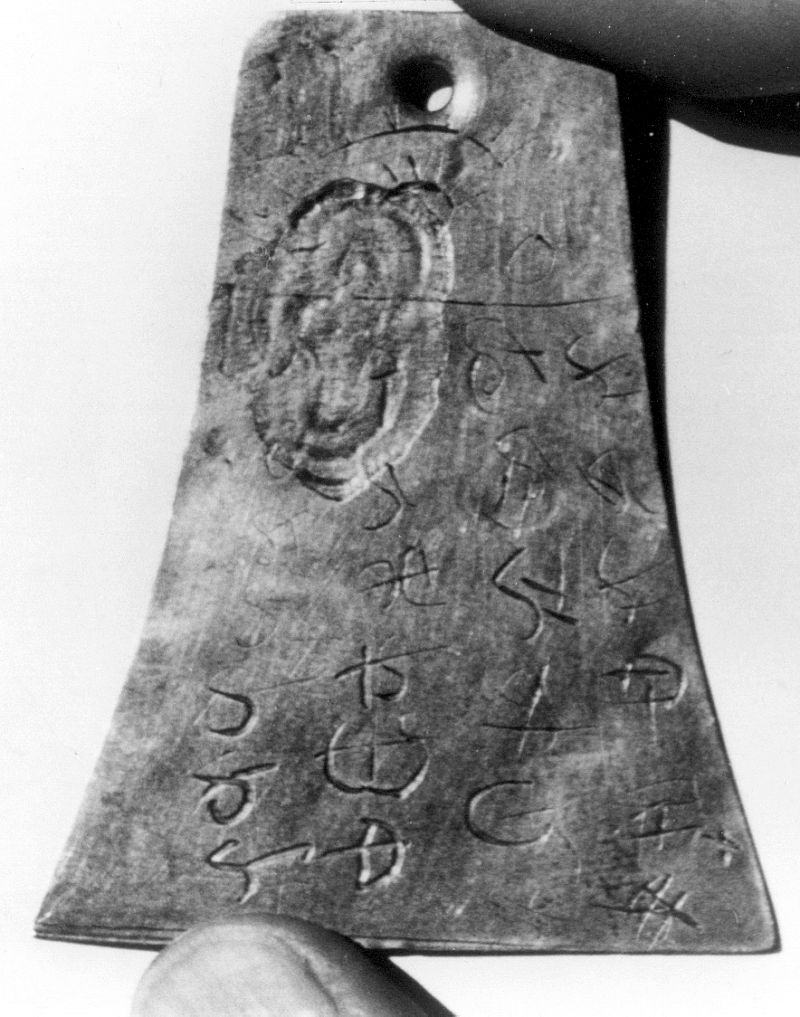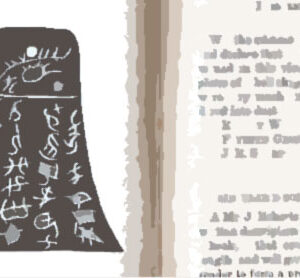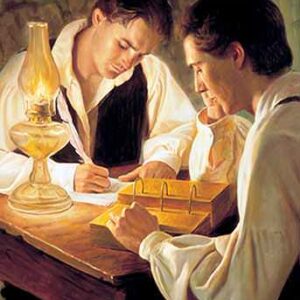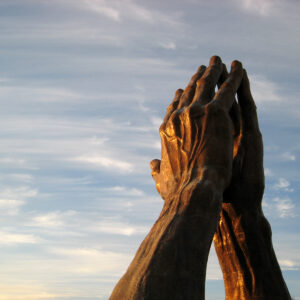1. Background: On April 16, 1843, Robert Wiley began digging a deep shaft in the middle of an Indian mound located just outside of Kinderhook, Illinois. The Quincy Whig newspaper reported that Wiley began the excavation project after dreaming of buried treasure beneath the mound. He initially undertook the excavation process alone before engaging the help of 10 to 12 men to assist him. In time, they unearthed “six plates of brass of a bell shape, each having a hole near the small end, and a ring through them all, and clasped with two clasps.” A member of the excavation team, W.P. Harris, took the plates home, washed them, and treated them with sulfuric acid. Once they were clean, he discovered that they were covered in strange characters resembling hieroglyphics.
The plates were briefly exhibited in the city, and then sent to Joseph Smith. The public was curious to know if Joseph would be able to decipher the symbols on the plates. The Times and Seasons claimed that the discovery of the Kinderhook plates lent further credibility to the Book of Mormon’s authenticity.
Joseph’s clerk and private secretary, William Clayton, recorded that upon receiving the plates, Joseph sent for his “Hebrew Bible & Lexicon,” suggesting he intended to translate the plates. On May 1, 1843, Clayton wrote in his journal that Joseph confirmed that the Kinderhook plates were genuine and that he had translated part of them:
“I have seen 6 brass plates … covered with ancient characters of language containing from 30 to 40 on each side of the plates. Prest. J. [Joseph Smith, Jr.] has translated a portion and says they contain the history of the person with whom they were found and he was a descendent of Ham through the loins of Pharaoh King of Egypt, and that he received his Kingdom from the ruler of heaven and earth.” (William Clayton, Joseph Smith, Jr.’s secretary, William Clayton’s Journal, May 1, 1843, as quoted in Trials of Discipleship – The Story of William Clayton, a Mormon, p. 117.)
Additionally, the History of the Church attributes the following statement to Joseph Smith: “I have translated a portion of [the plates] and find they contain the history of the person whom they were found. He was a descendent of Ham through the loins of Pharaoh King of Egypt, and that he received his Kingdom from the ruler of heaven and earth.” (History of the Church, Vol. 5, p. 372.)
Joseph Smith thought enough of “the history” of this Jaredite descendant of “Ham” to direct Reuben Hedlock to make woodcuts of the plates for future publication. History of the Church, 5:372–79. Just a month before his death, newspapers reported that he was “busy in translating them. The new work which Jo. is about to issue as a translation of these plates will be nothing more nor less than a sequel to the Book of Mormon.…” (Warsaw Signal, May 22, 1844.) The fact that Joseph Smith was actually preparing a translation of the plates is verified by an article published by an LDS newspaper, The Nauvoo Neighbor, on June 24, 1843. The article, containing facsimiles of the plates, stated: “The contents of the plates, together with a Fac-simile of the same, will be published in the ‘Times and Seasons,’ as soon as the translation is completed.” For years after the discovery, the Church heralded the plates as authentic.
2. Plates Revealed as Fraud: The Kinderhook hoax, however, began to unravel in 1855 when W.P. Harris, a witness who had helped unearth the plates, wrote a letter indicating that the plates were fraudulent. (W.P. Harris, letter to W.C. Flagg, 25 April 1855.) In June 1879, Wilbur Fugate – another of the original group who recovered the plates – confessed that the plates were fabricated in order to undermine Joseph Smith’s credibility as a prophet. (Wilbur Fugate, letter to James T. Cobb, 30 June 1879, in Welby W. Ricks, “The Kinderhook Plates,” Improvement Era 65 (Sept. 1962): 656, 658.)
Testing Confirms the Fraud: Some LDS members questioned whether the Harris and Fugate statements were credible and pointed to the fact that the artifacts were not available for independent testing, as they were lost about the time of the Civil War. In 1920, however, one of the plates came into the possession of the Chicago Historical Society. Welby W. Ricks, President of the BYU Archaeological Society, hailed the discovery as a vindication of Joseph Smith’s work:
A recent rediscovery of one of the Kinderhook plates which was examined by Joseph Smith, Jun., reaffirms his prophetic calling and reveals the false statements made by one of the finders.… The plates are now back in their original category of genuine.… Joseph Smith, Jun., stands as a true prophet and translator of ancient records by divine means and all the world is invited to investigate the truth which has sprung out of the earth not only of the Kinderhook plates, but of the Book of Mormon as well. (Welby W. Ricks, The Kinderhook Plates, reprinted from the Improvement Era, Sept. 1962.)
In 1965, the LDS church granted permission to George M. Lawrence, a Mormon physicist, to examine the plate. In his report Lawrence wrote: “The dimensions, tolerances, composition and workmanship are consistent with the facilities of an 1843 blacksmith shop and with the fraud stories of the original participants.”
In 1980, the Church authorized Dr. D. Lynn Johnson, a Northwestern University materials engineer and Latter-day Saint, to use the destructive methods necessary to accurately determine the plate’s age. In so doing, Dr. Johnson concluded that the plate was not of ancient origin. Instead, it was produced in the 1800s in a manner exactly as the Fugate had claimed. Dr. Johnson said: “The plate owned by the Chicago Historical Society, and known as the Kinderhook Plates, is made from a brass alloy consistent with the technology of the middle 19th Century. The characters on the plate were formed by etching with acid, probably nitric acid.” (D. Lynn Johnson, “Analysis of the Kinderhook Plate Owned by the Chicago Historical Society,” 10 pp., Nov. 1980.)
Additionally, further analysis verified that the tested plate could not have been a forgery of the Kinderhook Plates, but was in fact one of the actual plates discovered in Kinderhook in 1843. These tests confirmed the statements by Harris and Fugate about how the tablets were created in April 1843. Thereafter, the August 1981 edition of the Ensign confirmed that the plates were a hoax.
According to LDS historian Richard Bushman: “Church historians continued to insist on the authenticity of the Kinderhook plates until 1980 when an examination conducted by the Chicago Historical Society, possessor of one plate, proved it was a nineteenth-century creation.” (Bushman, Rough Stone Rolling, p. 490.)
3. Questions and Concerns: The evidence (including the Church’s own publications) establishes that Joseph claimed the Kinderhook plates were of ancient origin and that he had begun to translate them. Also, LDS historian Richard Bushman, in his book Rough Stone Rolling, relies on the evidence to indicate that Joseph Smith did start a translation of the fraudulent Kinderhook Plates.
The fraudulent plates raise several troubling concerns. How could the prophet Joseph Smith claim to have translated these invented symbols? How can it be true that the made-up symbols themselves provide an account of a descendant of Ham through the loins of Pharaoh, King of Egypt, as Joseph claimed? More importantly, in light of problems discovered with the Book of Abraham and the Kinderhook plates, can Joseph Smith be trusted in his claim that he translated a set of gold plates into the Book of Mormon?
4. Implications on Joseph Smith’s Role as Prophet and Seer: Since the gold plates (from which the Book of Mormon derived) were taken back by the angel Moroni, there is no tangible evidence to determine whether Joseph translated the plates correctly. In that context, both the Book of Abraham papyri and the Kinderhook Plates are incredibly valuable, as they can be objectively tested to verify many of Joseph Smith’s prophetic claims.
As outlined in the Book of Abraham section, Joseph Smith got everything wrong about the BOA papyri, the facsimiles, the names, the gods, the context, and the fact that the papyri and facsimiles were First Century funerary texts. There is not a single non-LDS Egyptologist who supports Joseph’s claims as they relate to the Book of Abraham. Even LDS Egyptologists acknowledge there are serious problems with both the Book of Abraham and Joseph’s claims. Likewise, Joseph claimed the Kinderhook plates were of ancient origin and that he had the ability to translate the plates. These claims proved to be false.
Joseph Smith made a scientific claim that he could translate ancient documents. This is a testable claim. Joseph failed the test with the Book of Abraham, and he failed with the Kinderhook Plates. In light of the historical evidence and Joseph Smith’s background, it is incredibly difficult to believe Joseph’s claim that he translated the Book of Mormon (particularly in the manner that will be described hereafter).



